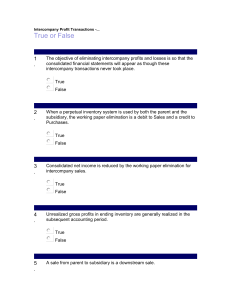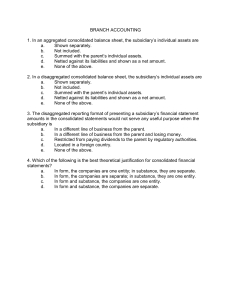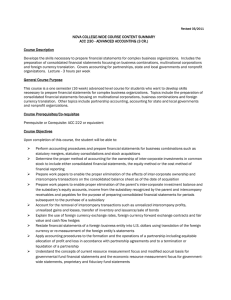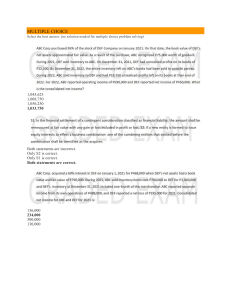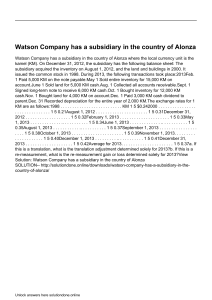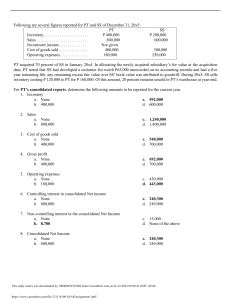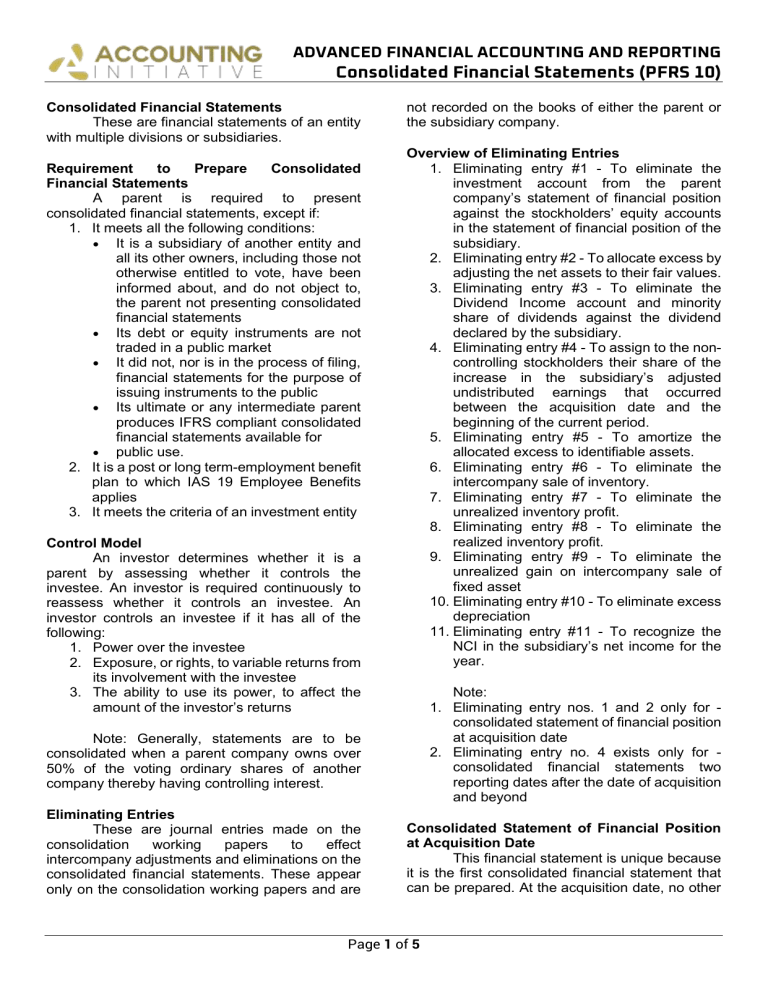
ADVANCED FINANCIAL ACCOUNTING AND REPORTING Consolidated Financial Statements (PFRS 10) Consolidated Financial Statements These are financial statements of an entity with multiple divisions or subsidiaries. Requirement to Prepare Consolidated Financial Statements A parent is required to present consolidated financial statements, except if: 1. It meets all the following conditions: • It is a subsidiary of another entity and all its other owners, including those not otherwise entitled to vote, have been informed about, and do not object to, the parent not presenting consolidated financial statements • Its debt or equity instruments are not traded in a public market • It did not, nor is in the process of filing, financial statements for the purpose of issuing instruments to the public • Its ultimate or any intermediate parent produces IFRS compliant consolidated financial statements available for • public use. 2. It is a post or long term-employment benefit plan to which IAS 19 Employee Benefits applies 3. It meets the criteria of an investment entity Control Model An investor determines whether it is a parent by assessing whether it controls the investee. An investor is required continuously to reassess whether it controls an investee. An investor controls an investee if it has all of the following: 1. Power over the investee 2. Exposure, or rights, to variable returns from its involvement with the investee 3. The ability to use its power, to affect the amount of the investor’s returns not recorded on the books of either the parent or the subsidiary company. Overview of Eliminating Entries 1. Eliminating entry #1 - To eliminate the investment account from the parent company’s statement of financial position against the stockholders’ equity accounts in the statement of financial position of the subsidiary. 2. Eliminating entry #2 - To allocate excess by adjusting the net assets to their fair values. 3. Eliminating entry #3 - To eliminate the Dividend Income account and minority share of dividends against the dividend declared by the subsidiary. 4. Eliminating entry #4 - To assign to the noncontrolling stockholders their share of the increase in the subsidiary’s adjusted undistributed earnings that occurred between the acquisition date and the beginning of the current period. 5. Eliminating entry #5 - To amortize the allocated excess to identifiable assets. 6. Eliminating entry #6 - To eliminate the intercompany sale of inventory. 7. Eliminating entry #7 - To eliminate the unrealized inventory profit. 8. Eliminating entry #8 - To eliminate the realized inventory profit. 9. Eliminating entry #9 - To eliminate the unrealized gain on intercompany sale of fixed asset 10. Eliminating entry #10 - To eliminate excess depreciation 11. Eliminating entry #11 - To recognize the NCI in the subsidiary’s net income for the year. Note: 1. Eliminating entry nos. 1 and 2 only for consolidated statement of financial position at acquisition date 2. Eliminating entry no. 4 exists only for consolidated financial statements two reporting dates after the date of acquisition and beyond Note: Generally, statements are to be consolidated when a parent company owns over 50% of the voting ordinary shares of another company thereby having controlling interest. Eliminating Entries These are journal entries made on the consolidation working papers to effect intercompany adjustments and eliminations on the consolidated financial statements. These appear only on the consolidation working papers and are Consolidated Statement of Financial Position at Acquisition Date This financial statement is unique because it is the first consolidated financial statement that can be prepared. At the acquisition date, no other Page 1 of 5 ADVANCED FINANCIAL ACCOUNTING AND REPORTING Consolidated Financial Statements (PFRS 10) transactions have occurred besides the business combination. Measurement of Non-Controlling Interest The following are the options provided by the Standard in measuring the non-controlling interest, in the order of priority: 1. At fair value (usually given); or 2. At the non-controlling interest’s proportionate share of the acquiree’s identifiable net assets, which is computed as follows: = (Consideration given / Percentage ownership of parent over subsidiary) * (1 - Percentage ownership of parent over subsidiary General Formula for Constructing Eliminating Entry Nos. 1 and 2 Fair Value Parent >50% NCI <50% Fair value of subsidiary A B C - Book value of interest acquired D E F = Excess G H I - Adjustment of identifiable accounts (e.g., Inventory, Land, Building, etc.) J = Goodwill (Gain from bargain purchase) K 6. F = E - D 7. G = A - D 8. H = B - E 9. I = C - F 10. J or Allocation of excess to adjust the net assets to their fair value = Fair value of identifiable account to be adjusted - Book value of identifiable account 11. K = G - J Eliminating Entry No. 1 The purpose of this eliminating entry is to eliminate the reciprocal accounts found in the books of the acquirer (Investment in Subsidiary) and acquiree (equity accounts). Also, it allows for the establishment of the initial balance of the NonControlling Interest account. Of course, if the acquiree is a wholly-owned subsidiary, there will be no NCI. Entry: Dr. Share capital - acquiree, Share premium - acquiree, Retained earnings - acquiree; Cr. Investment in subsidiary (E), Non-controlling interest (F) Eliminating Entry No. 2 The purpose of this eliminating entry is to allocate the excess of the fair value of the subsidiary over the book value of interest acquired to identifiable accounts whose fair values exceed the corresponding book values. Also, it allows for the establishment of the Goodwill or Gain from Bargain Purchase account. Entry: Dr. Identifiable accounts (J), Goodwill (balancing figure or K); Cr. Investment in subsidiary (H), Non-controlling interest (I), Gain from bargain purchase (balancing figure or K) 1. A = Consideration given / Percentage ownership of parent over subsidiary 2. B = Consideration given 3. C = Fair value of NCI or NCI’s proportionate share of the acquiree’s identifiable net assets 4. D = Acquiree’s: Share capital + Share premium + Retained earnings + Other equity accounts 5. E = D * Percentage ownership of parent over subsidiary Consolidated Financial Statements Subsequent to Date of Acquisition These statements may be affected by the other eliminating entries aside from nos. 1 and 2 since transactions have already been entered into between the date of acquisition and such date after the acquisition. Note: Whenever a parent consolidates statements, it has to use a different consolidation working paper and not just continue the previous one. Therefore, some entries will have to be repeated in order to effect proper consolidation. Eliminating Entry No. 3 The purpose of this eliminating entry is to eliminate the effect of distribution of dividend by the acquiree since under the consolidated financial Page 2 of 5 ADVANCED FINANCIAL ACCOUNTING AND REPORTING Consolidated Financial Statements (PFRS 10) statements, the parent and subsidiary are considered as one entity. Entry: Dr. Dividend income (acquirer), Noncontrolling interest (balancing figure); Cr. Dividends declared - acquiree Eliminating Entry No. 4 This entry is only made if after the acquisition date, at least one reporting period has already passed before the current reporting period. Its purpose is quite similar to eliminating entry no. 11. The only difference is that in this entry, the earnings being referred to are those from prior periods. Formula: Retained earnings - acquiree, beginning of current period Retained earnings - acquiree, date of acquisition = Increase in earnings - prior year Amortization of allocated excess in prior years = Adjusted undistributed earnings * Percentage ownership of NCI over subsidiary = Prior earnings assignable to NCI Entry: Dr. Retained earnings - acquiree (prior earnings assignable to NCI); Cr. NCI Upstream Intercompany Sales These are those sales made subsidiaries to the parent company. from Unrealized Gross Profit It exists in the ending inventory of the consolidated entity whenever there is an intercompany sale of inventory during the current period but the inventory was left unsold in the ending inventory of the buyer. This gross profit will only be realized once the involved inventory is sold. Intercompany Sale Transaction Analysis Selling Price Cost Gross Profit Beginning inventory A B C + Sales D E F - Ending inventory G H I = Cost of goods sold J K L Eliminating Entry No. 5 Since the identifiable net assets are already adjusted to fair value, it is just right to adjust their depreciation, amortization, effects on cost of goods sold, etc. because in such transactions, the acquiree is still using the book values. Entries: 1. Inventory: Excess is amortized as the inventory items are sold - Dr. Cost of goods sold; Cr. Inventory 2. Depreciable PPE: Excess is amortized as the property is depreciated - Dr. Operating expense; Cr. PPE (net) 3. Any PPE (depreciable or non-depreciable): Excess is amortized when the asset is sold or disposed - Dr. Gain on sale of PPE; Cr. PPE Downstream Intercompany Sales These are those made from a parent company to its subsidiaries. Page 3 of 5 1. A = Intercompany selling price of beginning inventory 2. B = Cost of beginning inventory before intercompany sale 3. C = A - B = A * Intercompany gross profit rate = Gross profit realized during the current period considering FIFO method is used 4. D = Intercompany sales during the current period 5. E = Cost of inventory (subject of intercompany sale) from outsiders 6. F = D - E = F * Intercompany gross profit rate 7. G = Intercompany selling price of ending inventory 8. H = Cost of ending inventory before intercompany sale 9. I = G - H = G * Intercompany gross profit rate = Unrealized gross profit at the end of the reporting period 10. J = A + D - G 11. K = B + E - H 12. L = C + F - I ADVANCED FINANCIAL ACCOUNTING AND REPORTING Consolidated Financial Statements (PFRS 10) Eliminating Entry No. 6 Since, the parent and the subsidiary are treated as one under the consolidated financial statements, the transactions of the consolidated entity with itself will have to be eliminated. The entry will be the same whether there has been a downstream or an upstream intercompany sale. Entry: Dr. Sales (D); Cr. Cost of goods sold Eliminating Entry No. 7 For example, the parent acquired a certain amount of inventory from the subsidiary. The subsidiary recognizes gross profit in its books arising from that sale; but the inventory is still in the ownership of the consolidated entity at the end of the reporting period. Therefore, such gross profit is still unrealized and will have to be eliminated. Entry: Dr. Cost of goods sold (I); Cr. Inventory Eliminating Entry No. 8 Continuing the example in eliminating entry no. 7, the parent sold the involved inventory to outsiders during the second year. It recognized gross profit on such sale based on: 1. The selling price to the external parties; and 2. The cost when the inventory was sold to it by the subsidiary (intercompany sale). The difference between the original cost of the inventory and the intercompany selling price is not yet recognized as gross profit. Therefore, an eliminating entry has to be made for the realized gross profit. Entry: 1. Downstream sale - Dr. Retained earnings, Jan. 1 - acquirer (C); Cr. Cost of goods sold 2. Upstream sale - Dr. Retained earnings, Jan. 1 - acquirer (C * percentage ownership of parent over subsidiary), Non-controlling interest (balancing figure); Cr. Cost of goods sold (C) Eliminating Entry No. 9 This is with regard to the intercompany sale of PPE. Since the parent and the subsidiary are considered as one under the consolidated financial statements, any gain or loss they earn or incur from intercompany sale of PPE will have to be eliminated. Such gain or loss is considered unrealized until the said PPE is sold to an external party or as the asset is being depreciated. Entry: Dr. PPE (balancing figure), Gain on sale of PPE (unrealized); Cr. Accumulated depreciation (balance that would have been show had the PPE not been sold) Eliminating Entry No. 10 For example, the PPE was sold by the Parent to its subsidiary at a gain. The subsidiary is now depreciating the PPE based on the cost when the latter was sold by the parent to the former which is higher than the original historical cost of the PPE. Therefore, there is excess depreciation that will have to be eliminated, Entry: Dr. Accumulated depreciation (excess depreciation); Cr. Depreciation Eliminating Entry No. 11 Its purpose is to recognize the share of the non-controlling interest in the comprehensive income of the acquiree. Formula: Comprehensive income from own operations - acquiree Amortization of excess + Realized intercompany profit in the beginning inventory from upstream sale Unrealized profit in the ending inventory from upstream sale Unrealized gain in the upstream sale of PPE + Excess depreciation on PPE acquired through a downstream sale = Realized comprehensive income from own operations - acquiree * Non-controlling interest’s percentage ownership over the subsidiary = Realized comprehensive income attributable to NCI Entry: Dr. NCI in CI of subsidiary; Cr. Noncontrolling interest Consolidated Comprehensive Income Attributable to the Acquirer Comprehensive income from own operations - acquirer Dividend income - acquirer. + Realized intercompany profit in the beginning inventory from downstream sale Unrealized profit in the ending inventory from downstream sale Unrealized gain in the downstream sale of Page 4 of 5 ADVANCED FINANCIAL ACCOUNTING AND REPORTING Consolidated Financial Statements (PFRS 10) + = + = PPE Excess depreciation on PPE acquired through an upstream sale Realized comprehensive income from own operations - acquirer Realized comprehensive income from own operations - acquiree Non-controlling interest’s percentage ownership over the subsidiary Consolidated comprehensive income attributable to the acquirer Consolidated Retained Earnings Retained earnings, reporting date acquirer + Acquirer’s share in the adjusted undistributed earnings of the acquiree = Consolidated retained earnings, reporting date or + = Retained earnings, beginning of reporting period Consolidated comprehensive income attributable to the acquirer Dividends paid - acquirer Consolidated retained earnings, reporting date Page 5 of 5
